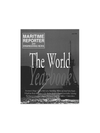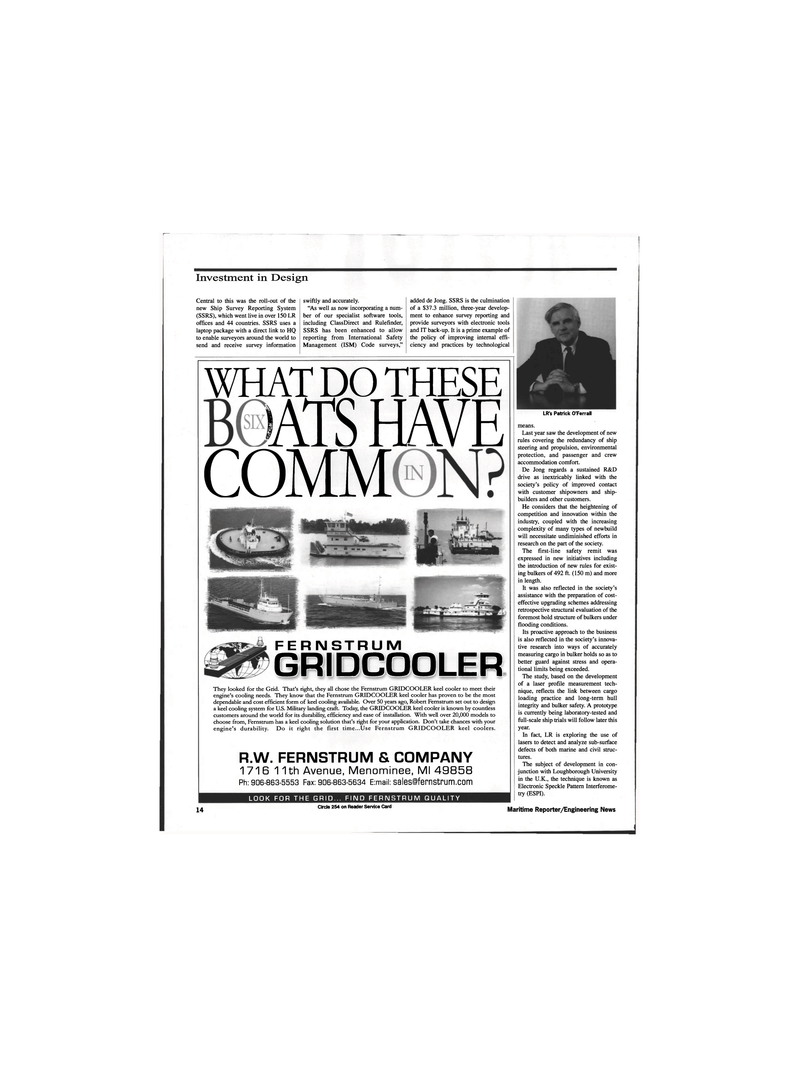
Page 14: of Maritime Reporter Magazine (June 1999)
Read this page in Pdf, Flash or Html5 edition of June 1999 Maritime Reporter Magazine
Investment in Design
Central to this was the roll-out of the new Ship Survey Reporting System (SSRS), which went live in over 150 LR offices and 44 countries. SSRS uses a laptop package with a direct link to HQ to enable surveyors around the world to send and receive survey information swiftly and accurately. "As well as now incorporating a num- ber of our specialist software tools, including ClassDirect and Rulefinder,
SSRS has been enhanced to allow reporting from International Safety
Management (ISM) Code surveys," added de Jong. SSRS is the culmination of a $37.3 million, three-year develop- ment to enhance survey reporting and provide surveyors with electronic tools and IT back-up. It is a prime example of the policy of improving internal effi- ciency and practices by technological
LR's Patrick O'Ferrall means.
Last year saw the development of new rules covering the redundancy of ship steering and propulsion, environmental protection, and passenger and crew accommodation comfort.
De Jong regards a sustained R&D drive as inextricably linked with the society's policy of improved contact with customer shipowners and ship- builders and other customers.
He considers that the heightening of competition and innovation within the industry, coupled with the increasing complexity of many types of newbuild will necessitate undiminished efforts in research on the part of the society.
The first-line safety remit was expressed in new initiatives including the introduction of new rules for exist- ing bulkers of 492 ft. (150 m) and more in length.
It was also reflected in the society's assistance with the preparation of cost- effective upgrading schemes addressing retrospective structural evaluation of the foremost hold structure of bulkers under flooding conditions.
Its proactive approach to the business is also reflected in the society's innova- tive research into ways of accurately measuring cargo in bulker holds so as to better guard against stress and opera- tional limits being exceeded.
The study, based on the development of a laser profile measurement tech- nique, reflects the link between cargo loading practice and long-term hull integrity and bulker safety. A prototype is currently being laboratory-tested and full-scale ship trials will follow later this year.
In fact, LR is exploring the use of lasers to detect and analyze sub-surface defects of both marine and civil struc- tures.
The subject of development in con- junction with Loughborough University in the U.K., the technique is known as
Electronic Speckle Pattern Interferome- try (ESPI).
WHAT DO THESE •ATS HAVE
COMM
FERNSTRUM GRIDCOOLER
They looked for the Grid. That's right, they all chose the Fernstrum GRIDCOOLER keel cooler to meet their engine's cooling needs. They know that the Fernstrum GRIDCOOLER keel cooler has proven to be the most dependable and cost efficient form of keel cooling available. Over 50 years ago, Robert Fernstrum set out to design a keel cooling system for U.S. Military landing craft. Today, the GRIDCOOLER keel cooler is known by coundess customers around the world for its durability, efficiency and ease of installation. With well over 20,000 models to choose from, Fernstrum has a keel cooling solution that's right for your application. Don't take chances with your engine's durability. Do it right the first time...Use Fernstrum GRIDCOOLER keel coolers.
R.W. FERNSTRUM & COMPANY 1716 11th Avenue, Menominee, Ml 49858
Ph: 906-863-5553 Fax: 906-863-5634 Email: [email protected]
LOOK FOR THE GRID... FIND FERNSTRUM QUALITY 14 Circle 254 on Reader Service Card Maritime Reporter/Engineering News

 13
13

 15
15
